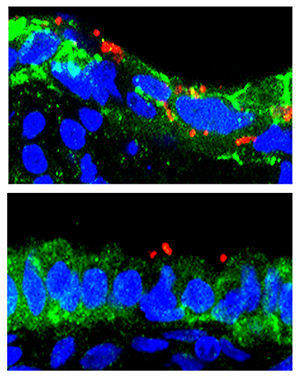UMD Files Patents on Compounds to Treat and Prevent Gonorrhea
Wenxia Song and her collaborators identified two molecules that inhibit gonorrhea infection in a laboratory tissue model
Gonorrhea, a sexually transmitted disease caused by the bacterium Neisseria gonorrhoeae, infects tens of millions of people worldwide every year. Antibiotics that previously treated gonorrhea lost their efficacy due to resistance, prompting the Centers for Disease Control and Prevention to call drug-resistant gonorrhea an urgent public health threat in 2013.
 In 2015, University of Maryland Cell Biology and Molecular Genetics Professor Wenxia Song and her collaborators found two molecules that could hinder gonorrhea-causing bacteria from infecting the human cervix in the laboratory. Song immediately wanted to use the discovery to help people.
In 2015, University of Maryland Cell Biology and Molecular Genetics Professor Wenxia Song and her collaborators found two molecules that could hinder gonorrhea-causing bacteria from infecting the human cervix in the laboratory. Song immediately wanted to use the discovery to help people.
“The fight against gonorrhea is a losing battle right now; it’s a public health crisis,” Song said. “When I saw that we had a possible way to prevent the infection and attack the bacteria, I wanted to take our finding out of the lab and into the clinic.”
UMD's Office of Technology Commercialization (OTC) filed patent applications on the composition and use of the two molecules to prevent and treat gonorrhea infection. OTC then licensed the patent rights to the two molecules to LovHealthee, a Maryland-based company which plans to use them to formulate and develop topical gels. LovHealthee plans to formulate and develop topical gels containing the molecules.
Song and her collaborators discovered the effects of these two molecules while studying how N. gonorrhoeae infected cultured tissue pieces taken from the human endocervix—the opening of the uterus and the initiation site of N. gonorrhoeae infection in women. In April 2017, Song’s group and her collaborators from the University of Maryland School of Medicine, Brigham and Women’s Hospital, and Harvard Medical School published their findings in the journal PLOS Pathogens.
Using a variety of imaging techniques, the researchers found that N. gonorrhoeae manipulated specific cellular signals in its human host, causing the endocervical lining to break down and shed its cells. This allowed N. gonorrhoeae to penetrate the endocervical tissue.
Knowing that one of the manipulated host signals was a human protein called myosin light chain kinase (MLCK), the researchers tested whether two MLCK-suppressing molecules—PIK and ML-7—could also suppress N. gonorrhoeae’s molecular manipulation. The researchers found that both molecules could inhibit N. gonorrhoeae-induced breakdown and shedding of the cervical lining, thus preventing N. gonorrhoeae from invading the tissue.
“N. gonorrhoeae tricks the endocervix lining into breaking itself down, allowing the bacteria to go in and out of the endocervix tissue freely,” Song explained. “By learning about the mechanism and what molecules the bacteria are triggering, we can find ways to inhibit and possibly prevent the infection process.”
Song said that gonorrhea has a complex infection mechanism. Therefore, she does not expect any single form of prevention or treatment to be a “silver bullet” against the disease.
“The endocervix is the primary area, but not the only area, N. gonorrhoeae infects in female patients, and we think the mechanism of establishing infection could be different elsewhere,” Song said. “If we can find more inhibitors, we can create a cocktail of medication for even more effective treatment.”
###
Other co-authors from UMD include Department of Cell Biology and Molecular Genetics Professor Daniel Stein, Department of Cell Biology and Molecular Genetics Assistant Clinical Professor Liang-Chun Wang, biological sciences graduate student Qian Yu, biochemistry major Jessica Qiu, and Brian Lin (B.S. ’14, biological sciences).
This work was supported by the National Institutes of Health (Award Nos. R21AI103797, RO1AI068888, R01DK068271 and AI123340). The content of this article does not necessarily reflect the views of this organization.
The research paper, “Neisseria gonorrhoeae infects the human endocervix by activating non-muscle myosin II-mediated epithelial exfoliation,” Liang-Chun Wang, Qian Yu, Vonetta Edwards, Brian Lin, Jessica Qiu, Jerrold Turner, Daniel Stein, and Wenxia Song, was published in the journal PLOS Pathogens on April 13, 2017.
University of Maryland
College of Computer, Mathematical, and Natural Sciences
2300 Symons Hall
College Park, MD 20742
www.cmns.umd.edu
@UMDscience
About the College of Computer, Mathematical, and Natural Sciences
The College of Computer, Mathematical, and Natural Sciences at the University of Maryland educates more than 9,000 future scientific leaders in its undergraduate and graduate programs each year. The college’s 10 departments and more than a dozen interdisciplinary research centers foster scientific discovery with annual sponsored research funding exceeding $175 million.







